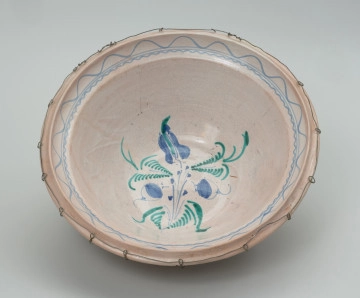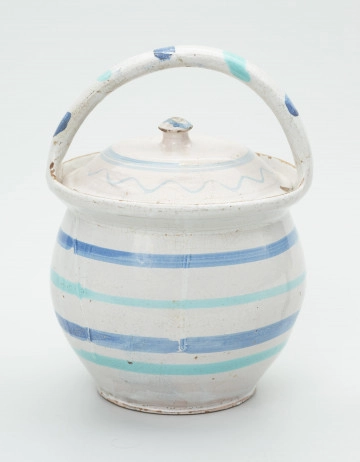
Bowl with wirework
1801 — 1850
National Museum in Szczecin
Part of the collection: White ceramics from Szczecin
In the 18th century, pottery workshops operated in more than thirty localities of the present West Pomeranian Voivodeship, and in the 19th century, their number increased even more. Lead-tin glazed pottery was particularly valued among buyers of clay products. The fashion for white ceramics came to West Pomerania with settlers from Friesland, Flanders and the Netherlands during the 18th century Frisian colonisation. The colonists, partly exempt from taxes, engaged in river and lake reclamation, could afford expensive white vessels. Local potters, adapting to the expectations of their customers and at the same time combining them with the local tradition, created their type of vessels, which over time, already in the 19th century, became known as Stettiner Ware. A large group were flat dishes - plates and bowls, which were glazed only on the face. Most of the plates had a straight edge of the spout, but it could also be regularly corrugated, as we can see in this case. The decoration of the dish is modest: between two stripes, there is a diagonal, thick grid and seven stylised palm leaves (?), at the ends of which dots are painted. The colours used are purple and green. The plate was probably made to order for a person who belonged to a more elite social group or aspired to it, if only for the desire to have elegant tableware.The 18th century and the first half of the 19th century were when the wealthy part of the society: the landed gentry, the rich bourgeoisie and even wealthy peasants, bought dishes with lead and tin glaze. In the middle of the 19th century, these groups started to use porcelain and faience dishes with white glaze became popular among villagers and the poorer bourgeoisie. At that time, their colouring was limited only to blue from cobalt oxide (CoO) and green from copper oxide (CuO).
Iwona Karwowska
Author / creator
Dimensions
cały obiekt: height: 4,5 cm, diameter: 16 cm
Object type
plate
Technique
wheel throwing, glaze-coating, pottery
Material
ceramic, slip (ceramic) , manganese oxide, copper oxide, lead-tin glazing
Origin / acquisition method
acquisition
Creation time / dating
Creation / finding place
Owner
Muzeum Narodowe w Szczecinie
Identification number
Location / status

1801 — 1850
National Museum in Szczecin

1841 — 1860
National Museum in Szczecin

1851 — 1900
National Museum in Szczecin
DISCOVER this TOPIC
National Museum in Lublin
DISCOVER this PATH
Educational path